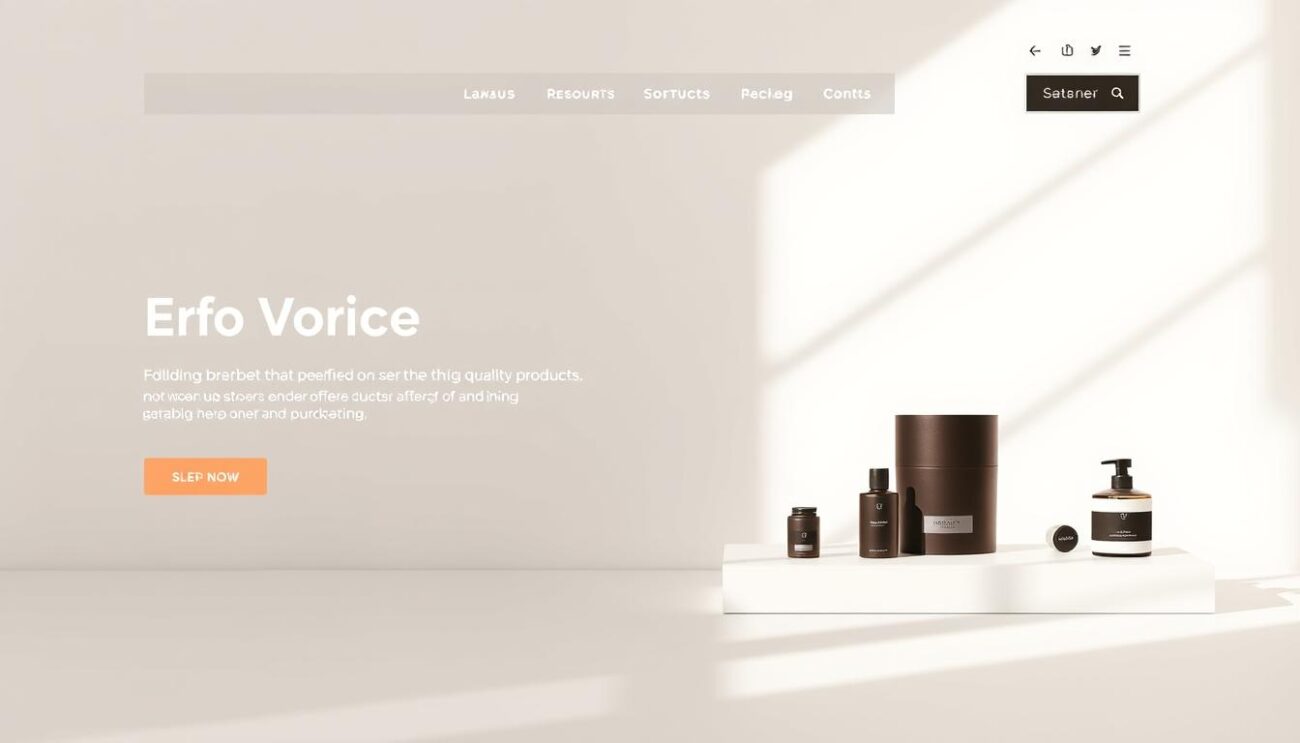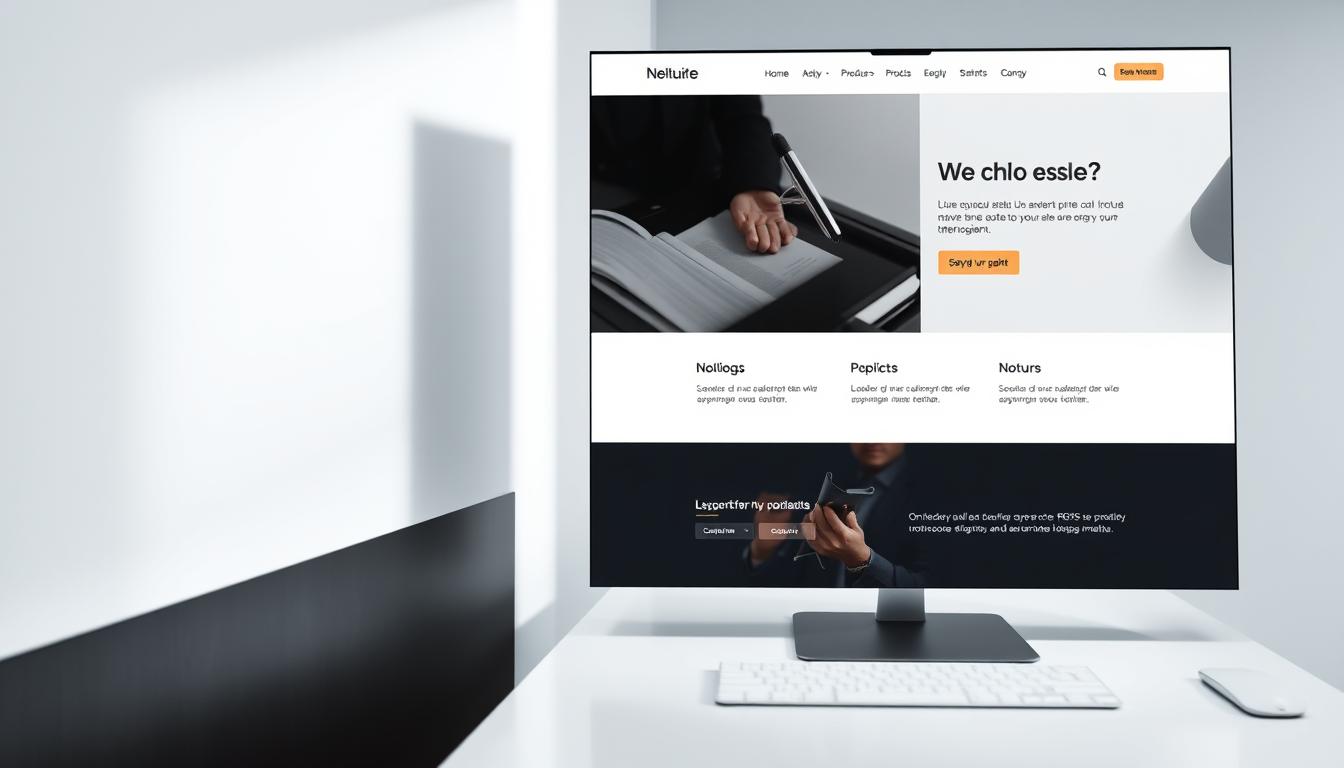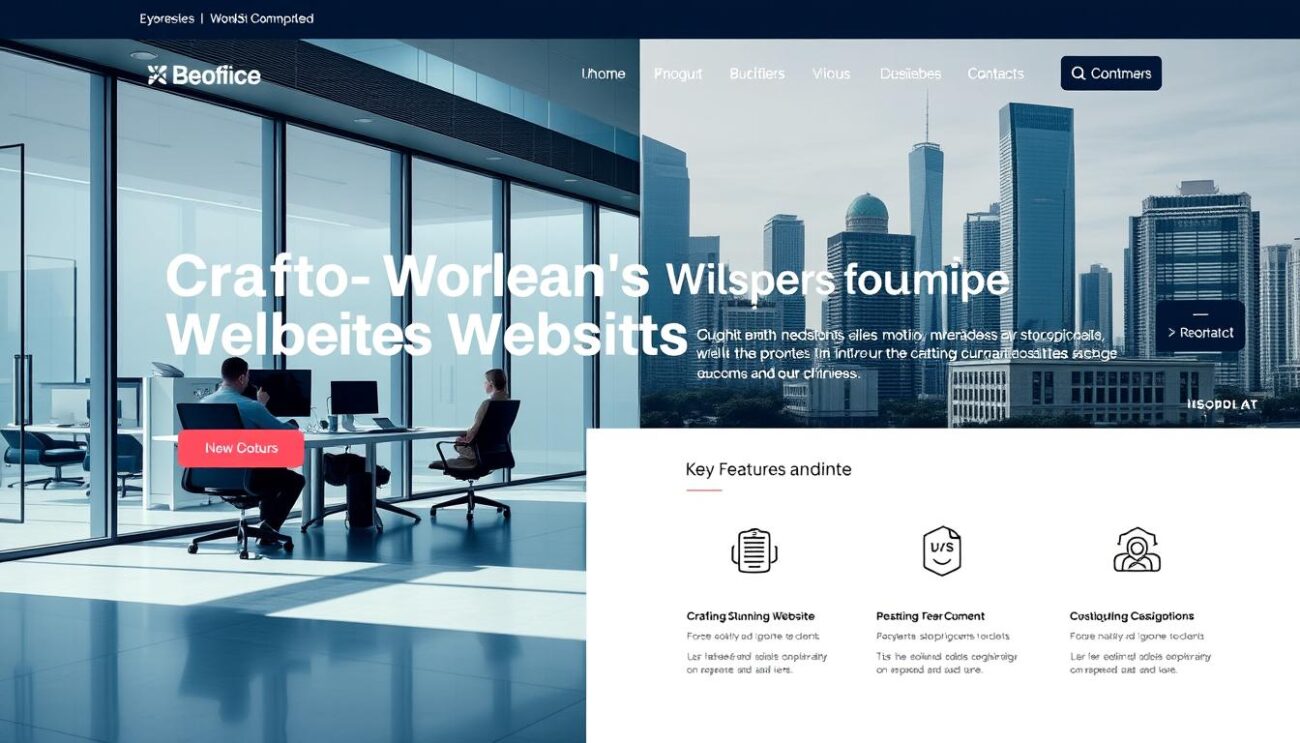In today’s digital age, having a professional online presence is crucial for businesses to establish a strong foundation. A well-crafted web design can help attract and engage with target audiences, drive conversions, and ultimately boost revenue.
A great example of a company that has successfully elevated its online presence through expert web development is Amazon, which has become a household name. By investing in a professional web design, businesses can reap numerous benefits, including increased brand visibility and credibility.
Key Takeaways
- Expert web design is crucial for establishing a strong online presence.
- A well-designed website can drive conversions and boost revenue.
- Investing in professional web development can increase brand visibility and credibility.
- A strong online presence is essential for businesses to succeed in today’s digital age.
- Companies like Amazon have successfully elevated their online presence through expert web design.
The Power of Web Design for Business Growth
As the first point of contact between a business and its potential customers, a website must be designed with both aesthetics and functionality in mind. In today’s competitive digital marketplace, a well-crafted website can be the difference between capturing a customer’s attention and losing them to a competitor.
First Impressions in the Digital Marketplace
The importance of making a good first impression cannot be overstated. Research has shown that it takes only 50 milliseconds for a user to form an opinion about a website. A cluttered, outdated, or difficult-to-navigate site can drive potential customers away, while a clean, modern, and user-friendly design can draw them in and keep them engaged.
Key elements of a positive first impression include:
- Clear and concise messaging
- Visually appealing design
- Easy navigation
- Fast loading speeds
Brand Identity and Visual Communication
Effective web design is not just about aesthetics; it’s also about communicating a brand’s identity and values. A well-designed website can convey a brand’s message, differentiate it from competitors, and create an emotional connection with its audience. Companies like Apple and Nike have successfully leveraged web design to reinforce their brand identities and build strong customer loyalty.
Visual communication plays a crucial role in this process, as it can evoke emotions, convey complex information in a simple way, and create a lasting impression. By incorporating a consistent visual language across their website, businesses can strengthen their brand identity and enhance user engagement.
Essential Elements of Professional Web Design
The elements of professional web design play a significant role in shaping the user experience. A well-crafted website is not just about aesthetics; it’s about creating an intuitive and engaging interaction between the user and the site.
User Experience (UX) Fundamentals
User experience is at the heart of professional web design. It encompasses various aspects, including usability, accessibility, and the overall interaction a user has with the website. A good UX design ensures that the website is easy to navigate, loads quickly, and provides valuable content to the user.
Key UX principles include:
- Clear and concise content
- Intuitive navigation
- Responsive design
- Accessible design elements
As Steve Krug, a renowned UX expert, once said,
“Don’t make me think” is a maxim that encapsulates the essence of good UX design.
Visual Hierarchy and Navigation
A well-structured visual hierarchy is crucial for guiding users through the website. It involves organizing content in a way that draws attention to the most important elements first. Effective navigation is also vital, as it enables users to find the information they need quickly and easily.
| Visual Hierarchy Elements | Description |
|---|---|
| Size and Scale | Using size to draw attention to important elements |
| Color and Contrast | Utilizing color to highlight key information |
| Positioning | Strategically placing elements to guide the user’s eye |
Color Psychology and Typography
Color psychology plays a significant role in web design, as different colors can evoke various emotions and reactions from users. Typography is also crucial, as it affects the readability and overall aesthetic of the website.
Color psychology considerations:
- Red: Energy, urgency, and importance
- Blue: Trust, calmness, and serenity
- Green: Growth, harmony, and nature
Typography should be chosen carefully to ensure it aligns with the brand’s identity and is legible across different devices.
Responsive Web Design: Creating Multi-Device Experiences
With the majority of internet users accessing websites through various devices, responsive web design has become crucial for a seamless user experience. As users switch between smartphones, tablets, and desktops, a responsive website adapts to their needs, providing an optimal viewing experience.
A key aspect of responsive web design is the mobile-first design approach. This methodology prioritizes the mobile user experience, ensuring that the most essential features and content are readily available on smaller screens. By doing so, businesses can effectively cater to the growing demographic of mobile users.
Mobile-First Design Approach
Adopting a mobile-first design approach involves several key considerations. First, it requires simplifying navigation and content to facilitate easy access on smaller screens. This can be achieved by:
- Streamlining menus and reducing the number of clicks to reach key information
- Prioritizing content, focusing on the most critical information
- Utilizing responsive typography to ensure readability across devices
Companies like Starbucks and Walmart have successfully implemented mobile-first design, resulting in improved user engagement and conversion rates.
Adaptive vs. Responsive Techniques
When it comes to creating multi-device experiences, two primary techniques are employed: adaptive and responsive design. While both methods aim to provide an optimal user experience, they differ in their approach:
| Design Technique | Description | Key Benefits |
|---|---|---|
| Responsive Design | Uses a single, flexible grid to adapt to various screen sizes | Easy maintenance, flexible layout |
| Adaptive Design | Employs multiple, fixed layouts tailored to specific screen sizes | Highly customized experience, fast loading times |
Responsive design is generally preferred for its flexibility and ease of maintenance, while adaptive design offers a more tailored experience for specific devices. The choice between the two ultimately depends on the project’s requirements and goals.
By understanding the principles of responsive web design and implementing a mobile-first approach, businesses can create engaging, multi-device experiences that drive user satisfaction and conversion.
How Web Design Impacts SEO Performance
The impact of web design on SEO performance is multifaceted, influencing how search engines crawl, index, and rank websites. A well-designed website is not only aesthetically pleasing but also crucial for enhancing search engine rankings and driving organic traffic.
Technical SEO Considerations
Technical SEO is a critical aspect of web design that involves optimizing a website’s underlying structure and elements to improve its visibility on search engines. This includes optimizing meta tags, using header tags (H1, H2, H3) to structure content, and ensuring clean and crawlable code. By focusing on these technical aspects, web designers can significantly improve a website’s SEO performance.
Moreover, technical SEO considerations extend to mobile-friendliness and SSL encryption, both of which are now essential for achieving good search engine rankings. A website that is not mobile-friendly or lacks SSL encryption may be penalized by search engines, negatively impacting its SEO performance.
Page Speed Optimization
Page speed is a critical factor in SEO performance, as search engines favor websites that load quickly. Optimizing images, minifying CSS and JavaScript files, and leveraging browser caching are some of the techniques used to improve page speed. A faster website not only improves user experience but also contributes to better search engine rankings.
Content Structure for Search Visibility
The structure of a website’s content plays a significant role in its search visibility. Organizing content with clear headings, using bullet points or numbered lists where appropriate, and ensuring that the content is easily scannable can enhance user experience and SEO. Moreover, incorporating relevant keywords naturally into the content can improve its visibility on search engines.
Effective content structure also involves creating content that is valuable and relevant to the target audience. By doing so, websites can increase user engagement, reduce bounce rates, and improve their overall SEO performance.
Current Web Design Trends in the American Market
The latest web design trends in the American market emphasize simplicity and interactivity, creating more engaging user experiences.
Minimalism and Purposeful Animation
Minimalism continues to be a dominant trend, with clean layouts and ample white space improving user focus. Purposeful animation enhances the user experience by providing feedback and guiding users through the website.
Companies like Dropbox have successfully implemented minimalistic designs, incorporating subtle animations to create a seamless user experience.
Dark Mode and Accessibility Features
Dark mode has become increasingly popular, offering users a visually comfortable experience, especially in low-light environments. It’s not just about aesthetics; dark mode can also contribute to energy efficiency on OLED screens.
Accessibility features are also gaining prominence, ensuring that websites are usable by everyone, including people with disabilities. This includes clear navigation, high contrast modes, and screen reader compatibility.
Micro-interactions and Immersive Experiences
Micro-interactions are subtle animations that occur in response to user actions, providing feedback and enhancing the overall user experience. Immersive experiences, on the other hand, engage users through interactive storytelling and 3D elements.
| Trend | Description | Benefits |
|---|---|---|
| Minimalism | Clean and simple design | Improved user focus, faster load times |
| Dark Mode | Low-light friendly interface | Energy efficiency, reduced eye strain |
| Micro-interactions | Subtle animations for feedback | Enhanced user experience, intuitive navigation |
The Web Design Process Explained
The web design process is a multifaceted journey that involves several critical stages, from understanding client needs to launching a fully functional website.
Discovery and Strategy Phase
The discovery phase is where the foundation of the web design project is laid. It’s a critical stage that involves understanding the client’s goals, target audience, and business objectives.
Client Goals and Target Audience Analysis
During this phase, designers work closely with clients to identify their goals and understand their target audience. This involves analyzing market trends, competitor activity, and customer behavior.
For instance, companies like IDEO and Frog Design have successfully implemented this process, resulting in websites that are both visually appealing and highly functional.
| Phase | Key Activities | Outcomes |
|---|---|---|
| Discovery | Client interviews, market research, competitor analysis | Clear understanding of client goals and target audience |
| Strategy | Developing a tailored strategy based on discovery findings | A well-defined project roadmap |
Design and Development Stage
The design and development stage is where the visual design and functionality of the website come together. This stage involves several key activities, including wireframing, prototyping, and iteration.
Wireframing, Prototyping, and Iteration
Wireframing involves creating a basic layout of the website’s structure and content. Prototyping takes this a step further by creating an interactive model of the site. Iteration involves refining the design based on feedback and testing.
Effective wireframing and prototyping are crucial for creating a user-friendly interface that meets client needs.

The outcome of this stage is a fully functional website that is both aesthetically pleasing and highly effective in meeting client objectives.
Balancing Aesthetics and Functionality in Web Design
In the digital landscape, a website’s success hinges on its ability to merge visual appeal with seamless functionality. Achieving this balance is crucial for engaging users and driving business growth.
Design Principles That Drive Engagement
To create an engaging website, designers must adhere to certain principles that enhance user experience. Visual hierarchy is crucial, as it guides users through the website’s content, highlighting important elements and calls-to-action. Color psychology also plays a significant role, as different colors can evoke various emotions and reactions from users.
Another key principle is typography, which not only affects the website’s aesthetics but also its readability. Choosing the right fonts and font sizes can significantly enhance user engagement. Moreover, micro-interactions can add a layer of interactivity, making the user experience more enjoyable and intuitive.
Performance Optimization Techniques
While aesthetics are crucial, the functionality of a website is equally important. Performance optimization techniques ensure that a website loads quickly and operates smoothly. One effective technique is image compression, which reduces the file size of images without compromising their quality.
Another critical aspect is code minification, which involves removing unnecessary characters from the website’s code to reduce its size. This can significantly improve page load times. Additionally, browser caching can enhance performance by storing frequently-used resources locally on users’ devices.
By balancing aesthetics and functionality, and by applying design principles that drive engagement and performance optimization techniques, businesses can create websites that not only attract users but also retain them. Companies like Pinterest and Instagram have successfully achieved this balance, providing their users with visually appealing and highly functional platforms.
E-commerce Web Design: Converting Visitors to Customers
A strategically designed e-commerce website can significantly boost conversion rates and drive business growth. In today’s competitive online marketplace, it’s crucial to create a seamless user experience that turns visitors into loyal customers.
Product Page Optimization
Optimizing product pages is essential for e-commerce success. This involves creating high-quality product images, writing detailed and compelling product descriptions, and ensuring that product information is easily accessible.
- Use clear and concise product titles
- Incorporate customer reviews and ratings
- Provide detailed product specifications
By implementing these strategies, businesses can improve customer engagement and increase the likelihood of a sale.
Checkout Process Streamlining
A streamlined checkout process is vital for reducing cart abandonment rates. This can be achieved by:
- Minimizing the number of steps required to complete a purchase
- Offering guest checkout options
- Ensuring that the checkout process is mobile-friendly
By simplifying the checkout process, e-commerce businesses can improve the overall user experience and increase conversion rates.

Trust Signals and Social Proof Integration
Incorporating trust signals and social proof is critical for building customer trust and confidence. This can be achieved by:
- Displaying trust badges and security certifications
- Showcasing customer testimonials and reviews
- Highlighting industry certifications and awards
By integrating these elements, businesses can create a more trustworthy and credible online presence.
In conclusion, effective e-commerce web design requires a multifaceted approach that includes product page optimization, checkout process streamlining, and trust signals integration. By implementing these strategies, businesses can improve conversion rates, drive sales, and foster customer loyalty.
Content Management Systems for Modern Web Design
Modern web design relies heavily on content management systems to create dynamic, user-friendly websites. A content management system (CMS) allows users to create, manage, and modify content on their website without needing to know how to code.
WordPress Design Customization
WordPress is one of the most popular CMS options, known for its flexibility and extensive customization capabilities. With thousands of themes and plugins available, users can tailor their website’s design and functionality to meet their specific needs. WordPress design customization allows businesses to create a unique online presence that aligns with their brand identity.
Shopify for E-commerce Businesses
For e-commerce businesses, Shopify offers a robust CMS solution that simplifies the process of managing online stores. Shopify provides a range of customizable themes and a user-friendly interface for managing products, orders, and customer data. Its scalability and integrations with various payment gateways make it a preferred choice for online retailers.
Headless CMS Solutions for Enterprise Websites
Headless CMS solutions are gaining popularity among enterprise websites due to their ability to provide a flexible and scalable architecture. A headless CMS decouples the content management from the presentation layer, allowing developers to use any front-end technology to display the content. This approach enables faster development and improved performance for complex websites.
In conclusion, content management systems play a vital role in modern web design by offering the flexibility, scalability, and customization needed to create effective online presences. Whether it’s through WordPress, Shopify, or headless CMS solutions, businesses can leverage these platforms to enhance their digital strategy.
How to Select the Right Web Design Agency in the US
The process of selecting a web design agency is more than just browsing through portfolios; it’s about finding a partner for your digital journey. In today’s competitive online landscape, a well-designed website is crucial for businesses looking to establish a strong brand identity and engage with their target audience.
Portfolio Assessment and Industry Experience
When evaluating potential web design agencies, one of the first things to consider is their portfolio and industry experience. A robust portfolio showcasing a variety of projects, especially those within your industry, is a good indicator of their capabilities and understanding of your specific needs. For instance, agencies like Big Spaceship and Imaginary Forces have demonstrated their expertise by delivering innovative web design solutions for prominent brands.
Reviewing their past work can provide insights into their design aesthetic, technical skills, and ability to meet client objectives. It’s also beneficial to look for case studies or testimonials that highlight their problem-solving approach and the results they’ve achieved for their clients.
Communication and Project Management Approach
Effective communication and a structured project management approach are vital for the success of your web design project. You need an agency that listens to your requirements, communicates clearly, and keeps you updated throughout the development process.
During your initial consultations, pay attention to how well the agency understands your business goals and how they propose to achieve them. A good web design agency should have a transparent project management process in place, including regular check-ins and milestones. This not only ensures that the project stays on track but also that you’re always informed about the progress.
Post-Launch Support and Maintenance Options
After your website is launched, you’ll need ongoing support to ensure it remains secure, updated, and continues to perform well. Inquire about the agency’s post-launch support and maintenance options. Some agencies offer comprehensive packages that include updates, backups, and security monitoring, which can be invaluable in maintaining your website’s integrity and performance over time.
Understanding their support structure and availability can provide peace of mind, knowing that you have a reliable partner to turn to if you encounter any issues or need further enhancements.
By carefully assessing a web design agency’s portfolio, communication approach, and post-launch support, you can make an informed decision that aligns with your business objectives and sets you up for long-term success in the digital marketplace.
Conclusion: Investing in Your Digital Future
Investing in expert web design is crucial for businesses aiming to establish a strong online presence and drive growth. A well-designed website not only enhances user experience but also boosts brand credibility and conversion rates.
By understanding the importance of web design and selecting the right web design agency, businesses can create a website that meets their needs and sets them up for success in the digital future. This investment in web design will yield long-term benefits, including improved brand visibility and customer engagement.
A strategic approach to web design, focusing on elements like user experience, visual hierarchy, and responsive design, will ensure that businesses stay ahead in the competitive digital landscape. As technology continues to evolve, a forward-thinking web design strategy will be essential for businesses to remain relevant and achieve their online goals.
FAQ
What is the importance of having a professional website for businesses?
Having a professional website is crucial for businesses to establish a strong online presence, attract and engage with target audiences, drive conversions, and ultimately boost revenue.
How does web design impact SEO performance?
Web design plays a significant role in SEO performance, as search engines favor websites that are user-friendly, fast, and well-structured. Technical SEO considerations, page speed optimization, and content structure all contribute to a website’s search visibility.
What are the essential elements of professional web design?
Professional web design involves several key elements, including intuitive navigation, a clear visual hierarchy, and thoughtful use of color and typography, which work together to create a seamless user experience.
What is responsive web design, and why is it necessary?
Responsive web design is an approach that ensures a website is optimized for multiple devices, including mobile phones and tablets. It is necessary because the majority of internet users access websites through mobile devices.
How do I select the right web design agency in the US?
When evaluating potential web design agencies, consider their portfolio, industry experience, communication and project management approach, and post-launch support and maintenance options to ensure you find the best fit for your business needs.
What are some current web design trends in the American market?
Current web design trends in the American market include minimalism, dark mode, micro-interactions, and immersive experiences, which can be incorporated into your web design to create a modern and engaging user experience.
What is the role of content management systems in modern web design?
Content management systems (CMS) have revolutionized the way we design and manage websites, offering flexibility and customization options for modern web design. Popular CMS options include WordPress, Shopify, and headless CMS solutions.
How can e-commerce web design be optimized for conversions?
E-commerce web design can be optimized for conversions by optimizing product pages, streamlining the checkout process, and incorporating trust signals and social proof, which can all contribute to a higher conversion rate.
What is the web design process, and what stages are involved?
The web design process involves several stages, including discovery and strategy, design and development, and post-launch support and maintenance. Understanding client goals and target audience is crucial in creating a website that meets their needs.


